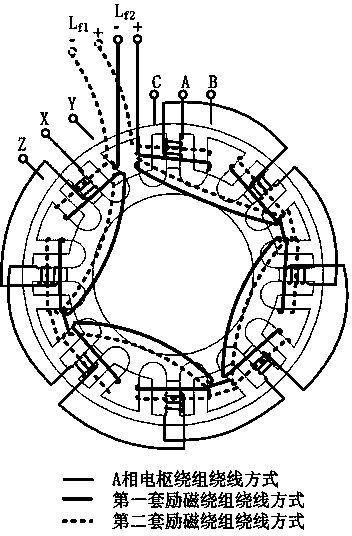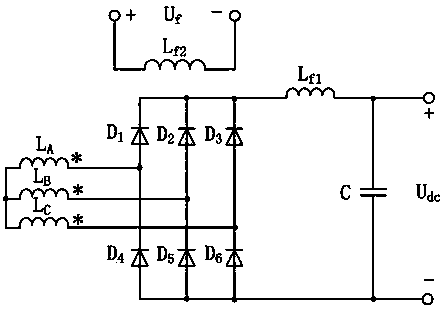Double excitation-winding compound-excitation double-salient brushless direct-current generator
A technology of double excitation winding and double salient motor, which is applied to synchronous generators, motors, electric vehicles, etc., can solve the problems of increased design requirements of power devices, large capacity of excitation controllers, and high cost of excitation controllers, and achieves simple design. , The effect of low excitation loss and high reliability
- Summary
- Abstract
- Description
- Claims
- Application Information
AI Technical Summary
Problems solved by technology
Method used
Image
Examples
specific Embodiment 1
[0027] Specific embodiment 1, a schematic diagram of a double-excitation double-salient pole brushless DC generator using a full-bridge rectifier circuit is shown in Figure 3:
[0028] Rectifier circuit part: the fourth rectifier diode D 4 and the first rectifier diode D 1 series, the fifth rectifier diode D 5 and the second rectifier diode D 2 series, the sixth rectifier diode D 6 and the third rectifier diode D 3 series, the fourth rectifier diode D 4 anode of the fifth rectifier diode D 5 The anode of the sixth rectifier diode D 6 The anode connection of the first rectifier diode D 1 cathode of the second rectifier diode D 2 The cathode of the third rectifier diode D 3 the cathode connection.
[0029] L A , L B , L C The input terminals of the three-phase armature windings are connected, L A , L B , L C The output ends of the three-phase windings are respectively connected to the first rectifier diode D 1 The anode of the second rectifier diode D 2 The ano...
specific Embodiment 2
[0030] Specific embodiment two, the schematic diagram when the double-excitation winding compound-excited double-salient pole brushless DC generator adopts the common-cathode zero-type rectifier circuit is as follows Figure 4 Shown:
[0031] LA , L B , L C The input terminals of the three-phase armature windings are connected, L A , L B , L C The output ends of the three-phase armature windings are respectively connected to the first to third rectifier diodes D 1 、D 2 、D 3 The anodes of the first to third rectifier diodes D 1 、D 2 、D 3 The cathode common connection. The first set of excitation winding L f1 One end of the third rectifier diode D 3 The cathode connection of the first set of field winding L f1 The other end of the output filter capacitor C is connected to one pole, the other pole of the output filter capacitor C is connected to the input end of the A-phase armature winding, and the second set of excitation winding L f2 Separately connected to the D...
specific Embodiment 3
[0032] Specific embodiment three, the schematic diagram when the double-excitation winding double-salient pole brushless DC generator adopts a common anode zero-type rectifier circuit is as follows Figure 5 Shown:
[0033] L A , L B , L C The input terminals of the three-phase armature windings are connected, L A , L B , L C The output ends of the three-phase armature windings are respectively connected to the first to third rectifier diodes D 1 、D 2 、D 3 The cathode is connected, the first to the third rectifier diode D 1 、D 2 、D 3 anode common connection. The C pole of the output filter capacitor and the third rectifier diode D 3 The anode of the output filter capacitor C is connected to the other pole of the first set of excitation winding L f1 One end of the connection, the first set of excitation winding L f1 The other end is connected to the input end of the A-phase armature winding, and the second set of excitation winding L f2 Separately connected to th...
PUM
 Login to View More
Login to View More Abstract
Description
Claims
Application Information
 Login to View More
Login to View More - R&D
- Intellectual Property
- Life Sciences
- Materials
- Tech Scout
- Unparalleled Data Quality
- Higher Quality Content
- 60% Fewer Hallucinations
Browse by: Latest US Patents, China's latest patents, Technical Efficacy Thesaurus, Application Domain, Technology Topic, Popular Technical Reports.
© 2025 PatSnap. All rights reserved.Legal|Privacy policy|Modern Slavery Act Transparency Statement|Sitemap|About US| Contact US: help@patsnap.com



